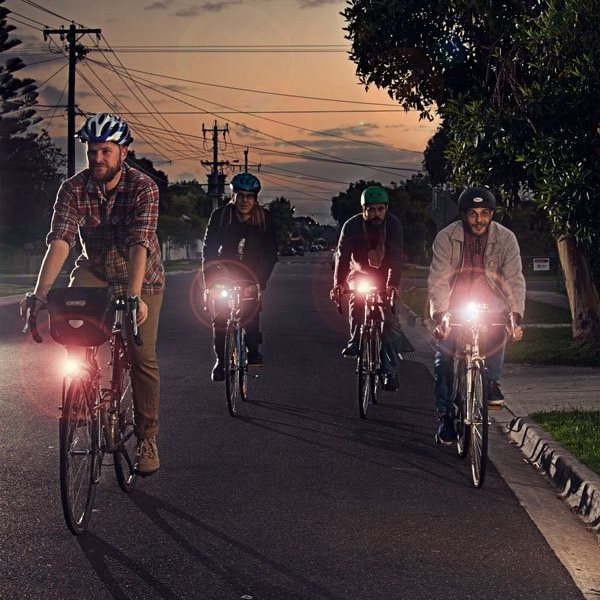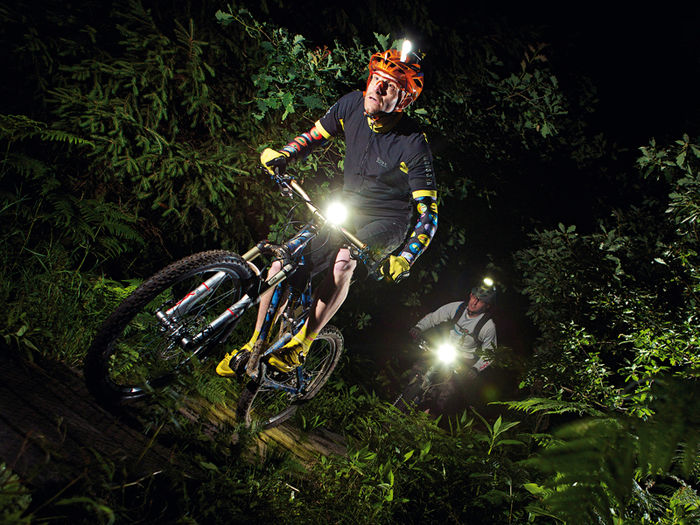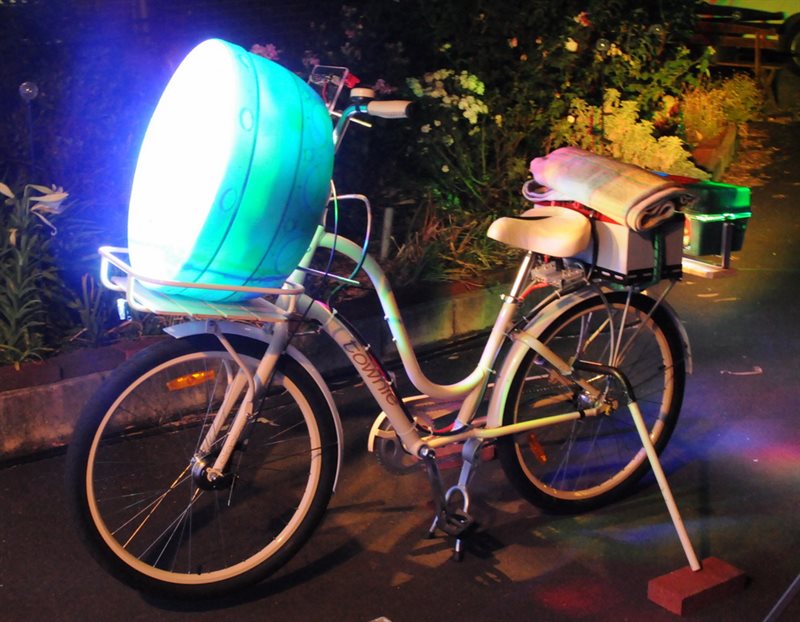It wasn’t that long ago that motorists could quite reasonably grumble about the lack of decent lighting emanating from most night-time bike riders. However, technology has moved on at a rapid pace and now you can get a decent set of powerful bike lights for less than $100 (and even more powerful if you have the cash to spare). However, with power comes responsibility, and it seems to me that many riders are forgetting that their super-bright lights can affect others.

It’s not so bad if you’re riding on the other side of the road. But since shifting house, my regular daily commute now takes me along more shared pathways. And now we’re in the winter months, with that I’ve seen a dramatic rise in the number of oncoming riders that seem to want to blind me and everyone else going the other way with their super-charged bike lights.
Here’s a test: At night, have someone hold your bike and switch your lights on, then stand about 10m in front of it. I suspect that for a good number of you, you may be surprised at the over-bright light shining back in your face. Just because some of it is lighting up the road surface doesn’t mean you have it pointed the right way. In fact, riding past some recent offenders, I can see quite clearly side-on that their bike light is mounted virtually horizontal. There is a simple solution – POINT IT DOWN! If it’s a particularly omni-directional light, you may even want to consider fixing some duct-tape to the top to prevent the upward light spill.

Another way to test: you know those typical street signs that are usually a few metres off the ground? If they’re reflecting or flashing as you ride by, then your lights are pointed too high.
Another annoying trend I’m noticing is the tendency for everyday riders to also wear head-mounted lighting as well as the standard handlebar-mounted ones. So even if the bike-mounted lights are pointing in the right direction, it doesn’t take much for the rider to look in your direction and WHAM! You have another face-full of lumens to contend with.

Sorry, but these things need to be confined to the mountain-bike tracks (or the winter solstice rides). Despite your best intentions, there is no way you will avoid sooner or later pointing that light in someone’s face (rider or driver) and really p**ing them off. Need more light on your ride? Put a second bike-light on your handlebars.
Bike lighting is a fine balance between being able to see other objects and being seen by others. Too much emphasis on the former and others may struggle to safely see you (and avoid you). The law is quite clear: “You must not use cycle lighting equipment in such a way that it dazzles, confuses, or distracts so as to endanger the safety of other road users.”

What do YOU think about current bike lighting practices?


Thanks LennyBoy, a timely and accurate post. I’ve been nearly blinded by oncoming cyclists while travelling home through Hagley Park at night. Thanks for the tip about checking our own lights as I’d also been wondering if one of my own front lights might not be optimal in this regard.
I completely agree with responsible use. Another factor to consider is it’s really hard for other road users to judge distance from very bright horizontal lights. 100m & 10m look quite similar so riders doing that may not be actually improving their own safety at all, or could even be making it worse.
I’m using high power LED (600-900 lumen from dx.com) on handle bars pointed so that it’s centred on road 2-3m in front of bike. Lent it against fence, walked away & it’s good from front. Not great some side though & disappears quite quickly unless you look at the road rather than the bike.
Do disagree to some extent with comment about never using helmet lights on road. Many of the ‘attacks’ come from side on & I’m sure my helmet light has saved me a few times. I’ve got it pointed to similar spot on road as handlebar light in normal riding position, but it is possible to lift head & shine it at approaching hazards. I do need to be aware of it as at traffic lights while standing it’s easy to have to pointing nearer horizontal.
I have a head-light torch, and its quite bright. However during normal riding its aimed at the ground, about three metres in front of me. If I want to point it somewhere, I have to raise my head to do so.
I also have a UV torch that is aimed from my handlebars back at my cycling vest… it makes that yellow flouro light up really well at night.
Plus a normal flinking front and a pair of back ones too.
For the next winter solstice I’m thinking about something involving EL wire…
UV torch ? Keen to know more.
I’d considered small light on bike pointing towards reflective hi viz but waste of time as the light reflects back towards the light source, not all directions.
Its not the sort of thing that photographs very well, I’ve tried.
The torch is a $6 cheapie from here
http://www.dx.com/p/12-led-uv-flashlight-silver-3xaaa-4014#.U8W0zZUaGIg
Is UV more effective than other types of light source ?
For lighting up flouro – definitely! Those yellow/green/orange flourescent colours use dyes that reflect UV light but at a lower wavelength, essentially converting UV light into visible light.
Makes the object appear brighter than it really is.
This effect slowly wears off with age and sunlight.
During the colder months I use a 500 lumen light only because I cycle through a dark wooded road with no street lights around. I still angle it downwards a bit though. I feel it is too bright to use on flashing/strobe while in the city, so I leave it on constant. I know a few fellow cyclists who buy less powerful lights so they can use them for flashing.
Agree with pretty much everything everyone has said, and have wanted to have a rant about high-powered flashing lights on shared pathways myself for a while. The question I’ve got is, how do we actually solve the problem? Your blog has raised the issue with a certain amount of people, but I don’t think it’s going to solve the problem overnight. This issue seems to have flared up due to the recent availability of cheap, high-powered lights, and as with many other developments in technology, etiquitte around their use may take time to develop. How can good use of lights be promoted effictively among the wider cycling population?
Meanwhile, best just to do what the road code says when being blinded by approaching vehicles’ headlights: look to the left hand side of the road (/path) – and chill out (more a note to self).
Educating appropriate use will be difficult as very few people read instructions ! Still it’s far better a rider has a high power light used wrongly than a dim light or no light at all.
The thing about a bike is that the rider is not hidden behind a layer of glass and soundproofing. Just yell out “cheesus that’s bright!” or cover your eyes and yell out “ARGH! IT BURNS!!!”
I agree with what everyone has said. I had got a 600 lumen light on my bike and a 200 lumen on my helmet and I have had people hooting at me just because my lights are too powerful for them. I saw a glow belt ad on a car so visited their website to investigate and ended up buying two green LED flashing belts for $40 that I use everyday and now I just have to use a 200 lumen lamp as the belt makes me visible from the front and the back as well. The good thing about these belts is that they are USB rechargeable so I don’t have to worry about replacing batteries.
http://www.glowbelt.co.nz
Good article. I suppose it’s about trying to find a balance between ensuring you will be seen without overdoing it.
I’m probably guilty of the above as my front light is quite bright and I currently have it mounted at horizontal. I used to have it tilted down slightly but I had a run-in with a car who cut me off and then claimed they didn’t see me (despite a bright flashing light) concerned me, so ended up lifting it back to horizontal.
That way I figured that at least they can’t say they didn’t see me coming.
Perhaps I will lower it down a bit again.
The thing about lights is everyone would rather see 10 cyclists using lights badly than 1 with no lights & we’d rather see 100 or more using lights badly than 1 fatality because they were not seen.
Regardless though, lights are down the priority list compared to improving the behaviour of some drivers and cyclists. Awareness & respect need to majorly improve before safety will improve. Better infrastructure will help but top the pile will always be behaviour.
Respectful use of lights is a tiny bit of the that good respectful behaviour. Its helps however in my opinion is not a major contributor to improving cyclist safety.
Right on the money, Lenny. Well put.
What about in the daytime? Should one have lights on their bike when riding during the day?
Great writing about mountain bike lights. Mountain biking at night is just amazing and is not possible without light. If you are seeking kind of light you me keep your eyes on https://coolidealbike.com/best-mountain-bike-lights-review-tips/ here to make enjoyable and adventures journey at night.
Hi I Think the big problem is the lights worn on the head as people seem to look at the driver to see what the next move is, in our family we have all got the CL1800L 1800Lum lights from http://www.bikeforlife.co.nz and that has 7 settings and on the brighter roads we keep them on lowest settings, Now worries.
Cheers
Mike
I noticed this is a real issue here, and I came across this old post because of the reminder about lighting send out by the council today. I used to live in Germany, which in turn used to have sensible regulations about bike lights, namely that the light must be attached to bike (not the helmet), must be non-flashing, and must be angled in a way that the middle line of the light cone is half-way down after 5 m (in essence, the light is pointing downwards, not upwards). Unfortunately, they got rid of the last requirement and replaced that with “non-blinding”, but I think it made sense, and every bicycle sold in Germany would meet the requirements or not be street-legal. Being blinded by oncoming cyclists was much less of an issue here. I do wonder whether NZ will consider similar regulations, particularly with the increase in cycling traffic. Incidentally, this is one of my issues with the Lime scooters: they have an upward-pointing light. I sincerely hope that the scooter traffic will drastically decrease in the winter months, because I am not looking forward to being blinded by scooters while riding as well.